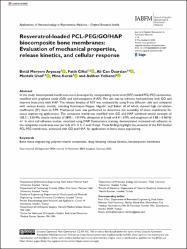Resveratrol-Loaded PCL-PEG/GO/HAP Biocomposite Bone Membranes: Evaluation of Mechanical Properties, Release Kinetics and Cellular Response

View/
Access
info:eu-repo/semantics/openAccessDate
2025Author
Arpaçay, Betül MeryemÇiftçi, Fatih
Özarslan, Ali Can
Ünal, Mustafa
Kucak, Mine
Yelkenci, Aslıhan
Metadata
Show full item recordCitation
ARPAÇAY, Betül Meryem, Fatih ÇİFTÇİ, Ali Can ÖZARSLAN, Mustafa ÜNAL, Mine KUCAK & Aslıhan YELKENCİ. "Resveratrol-Loaded PCL-PEG/GO/HAP Biocomposite Bone Membranes: Evaluation of Mechanical Properties, Release Kinetics and Cellular Response". Journal of Applied Biomaterials & Functional Materials, (2025): 1-16.Abstract
In this study, biocomposite membranes were developed by incorporating resveratrol (RSV)-loaded PCL-PEG composites, modified with graphene oxide (GO) and hydroxyapatite (HAP). The aim was to enhance hydrophilicity with GO and improve bioactivity with HAP. The release kinetics of RSV was evaluated by using Franz diffusion cells and compared with various kinetic models, including Korsmeyer-Peppas, Higuchi, and Baker, all of which showed high correlation coefficients (R²) close to 0.99. Mechanical tests was performed to determine the suitability of these membranes for tissue engineering applications. The composite membrane modified with GO and HAP exhibited tensile strength of 105.2 ± 5.8 MPa, tensile modulus of 3895 ± 159 MPa, elongation at break of 8.4 ± 0.9%, and toughness of 5.88 ± 0.46 MJ/m³. In vitro cell adhesion studies, visualized using DAPI fluorescence staining, demonstrated increased cell adhesion to the composite membranes over periods of 1, 3, 5, 7, and 14 days. These findings highlight the potential of the RSV-loaded PCL-PEG membranes, enhanced with GO and HAP, for applications in bone tissue engineering.


















